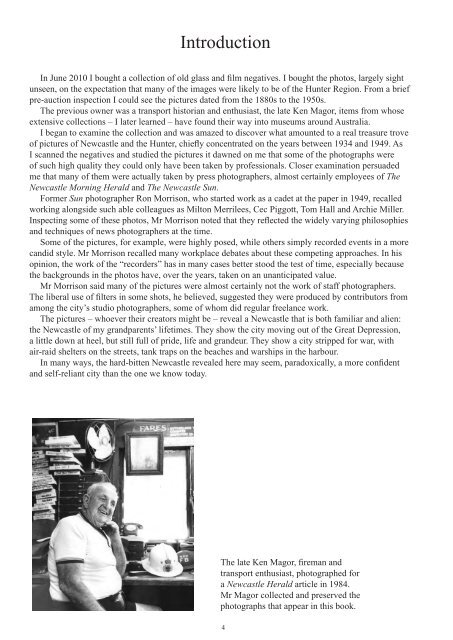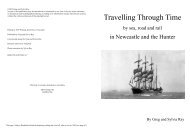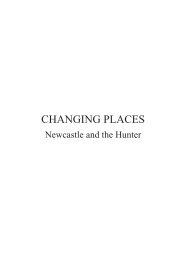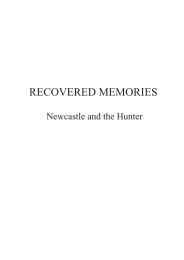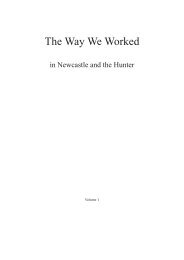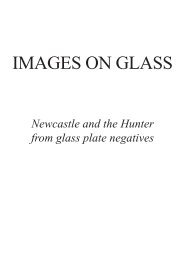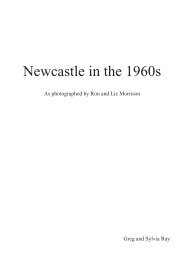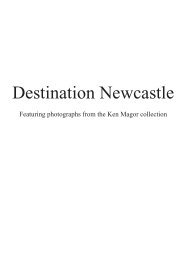Pages from Newcastle Missing Years 8th print 2016
You also want an ePaper? Increase the reach of your titles
YUMPU automatically turns print PDFs into web optimized ePapers that Google loves.
Introduction<br />
In June 2010 I bought a collection of old glass and film negatives. I bought the photos, largely sight<br />
unseen, on the expectation that many of the images were likely to be of the Hunter Region. From a brief<br />
pre-auction inspection I could see the pictures dated <strong>from</strong> the 1880s to the 1950s.<br />
The previous owner was a transport historian and enthusiast, the late Ken Magor, items <strong>from</strong> whose<br />
extensive collections – I later learned – have found their way into museums around Australia.<br />
I began to examine the collection and was amazed to discover what amounted to a real treasure trove<br />
of pictures of <strong>Newcastle</strong> and the Hunter, chiefly concentrated on the years between 1934 and 1949. As<br />
I scanned the negatives and studied the pictures it dawned on me that some of the photographs were<br />
of such high quality they could only have been taken by professionals. Closer examination persuaded<br />
me that many of them were actually taken by press photographers, almost certainly employees of The<br />
<strong>Newcastle</strong> Morning Herald and The <strong>Newcastle</strong> Sun.<br />
Former Sun photographer Ron Morrison, who started work as a cadet at the paper in 1949, recalled<br />
working alongside such able colleagues as Milton Merrilees, Cec Piggott, Tom Hall and Archie Miller.<br />
Inspecting some of these photos, Mr Morrison noted that they reflected the widely varying philosophies<br />
and techniques of news photographers at the time.<br />
Some of the pictures, for example, were highly posed, while others simply recorded events in a more<br />
candid style. Mr Morrison recalled many workplace debates about these competing approaches. In his<br />
opinion, the work of the “recorders” has in many cases better stood the test of time, especially because<br />
the backgrounds in the photos have, over the years, taken on an unanticipated value.<br />
Mr Morrison said many of the pictures were almost certainly not the work of staff photographers.<br />
The liberal use of filters in some shots, he believed, suggested they were produced by contributors <strong>from</strong><br />
among the city’s studio photographers, some of whom did regular freelance work.<br />
The pictures – whoever their creators might be – reveal a <strong>Newcastle</strong> that is both familiar and alien:<br />
the <strong>Newcastle</strong> of my grandparents’ lifetimes. They show the city moving out of the Great Depression,<br />
a little down at heel, but still full of pride, life and grandeur. They show a city stripped for war, with<br />
air-raid shelters on the streets, tank traps on the beaches and warships in the harbour.<br />
In many ways, the hard-bitten <strong>Newcastle</strong> revealed here may seem, paradoxically, a more confident<br />
and self-reliant city than the one we know today.<br />
The late Ken Magor, fireman and<br />
transport enthusiast, photographed for<br />
a <strong>Newcastle</strong> Herald article in 1984.<br />
Mr Magor collected and preserved the<br />
photographs that appear in this book.<br />
4


